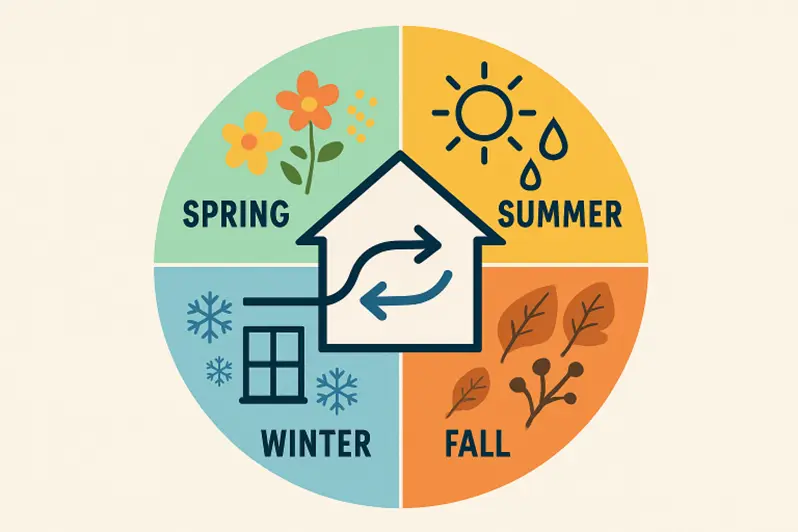How Seasonal Changes Affect Indoor Air Quality
Indoor air quality impacts allergies, asthma, and cognition, making understanding what affects your IAQ year-round is crucial. This knowledge helps you take preventive steps to protect your family and guests. Even with good cleaning routines, seasonal changes can introduce new challenges. EPA reports that managing these is vital, especially as climate change worsens wildfires and extends allergy seasons.
Most people don’t realize how much the ebb and flow of the seasons can affect the air they breathe at home. Each shift, whether it’s the blooming of spring or the chill of winter, brings new concerns for indoor environments. Maintaining healthy air inside is essential for physical comfort, year-round wellness, and long-term respiratory health. For residents looking to optimize their home’s air quality, Chill Factor Cooling and Heating in Norco provides expert insight and solutions tailored to every season.
Our homes are dynamic environments. Weather patterns, outdoor allergens, and moisture levels change throughout the year, and so do the ways those elements penetrate our living spaces. Understanding these annual patterns—and taking steps to adapt—can improve not just the air we breathe, but the quality of our daily lives.
Springtime Allergens and Mold Growth
Spring brings indoor air quality challenges: rising outdoor temperatures and pollen infiltration through open windows and clothing cause allergies and asthma issues. Melting snow and rain increase moisture, leading to mold in damp areas, which worsens allergies and respiratory problems. To reduce risks, ensure proper ventilation, use dehumidifiers, and detect leaks for a healthier home transition.
Summer Humidity and Volatile Organic Compounds
Summer’s high humidity negatively impacts indoor air quality by promoting dust mite and mold growth, exacerbated by moisture accumulation in household items. Increased outdoor pollutant infiltration, such as pollen and vehicle emissions, occurs when windows are opened for ventilation. Elevated temperatures also heighten risks from volatile organic compounds (VOCs), which are released by various household products and tend to vaporize and persist in warmer conditions. Mitigation strategies include maintaining indoor humidity levels between 30-50% using a dehumidifier, and reducing exposure to VOCs by choosing low-VOC or natural product alternatives.
Fall Mold Spores and Decaying Organic Matter
As fall weather sets in, indoor air quality can be impacted by several factors. The decomposition of decaying leaves and organic matter outdoors releases mold spores into the air, particularly following wet conditions. Additionally, the initial use of heating systems after dormancy can agitate settled dust within HVAC systems and on home surfaces. To address these hazards, it is recommended that HVAC systems be serviced or filters be replaced before seasonal use. Maintaining clean gutters and regularly clearing fallen leaves around the home helps prevent mold accumulation. Furthermore, inspections of less-frequented areas such as attics and basements are advised to identify any hidden moisture issues or leaks.
Winter Stagnant Air and Indoor Pollutants
Winter keeps us indoors, trapping pollutants and allergens through closed windows and limited ventilation. Furnaces, heaters, and fireplaces emit carbon monoxide and particulates. Dust, pet dander, and VOCs from holiday candles or decorations worsen indoor air quality. To improve air quality, open windows briefly on mild days, regularly test and service heating appliances, and use a HEPA air purifier in bedrooms or living areas.
Wildfire Smoke and Indoor Air Quality
Increasingly, wildfire smoke has become a major seasonal threat, far beyond its immediate regions. These fine particles seep indoors, even when windows and doors are shut, posing severe risks for everyone—especially children, seniors, and those with respiratory illnesses. When air quality alerts are issued, keep all entry points closed, run air purifiers, and ensure that HVAC systems have clean, high-quality filters.
Wildfire smoke’s impact on IAQ reminds us just how vulnerable our indoor spaces are to outside events. Protecting yourself during fire season is about prevention and preparation year-round.
Tips for Maintaining Good Indoor Air Quality Year-Round
To improve indoor air quality and protect family health, it is recommended that regular maintenance of HVAC systems be performed by frequently replacing filters and scheduling annual professional servicing. Ventilation is crucial; utilize exhaust fans in kitchens and bathrooms or open windows to mitigate moisture and pollutants at their origin. Promptly address any water leaks to prevent the development of mold. Minimize using home products containing chemicals and implement a weekly cleaning routine to decrease dust, dander, and other airborne irritants. It is also advisable to monitor regional air quality, particularly during events such as wildfires or allergy seasons, to make informed decisions that ensure year-round health and comfort.
Conclusion
Maintaining healthy indoor air quality is a year-round commitment that requires seasonal awareness and proactive care. Each season, from spring pollen and summer humidity to fall mold and winter pollutants, presents unique challenges that can impact respiratory health and overall well-being. Wildfire smoke further underscores the importance of preparation, as its effects reach far beyond local fire zones. Combining preventive measures—such as proper ventilation, regular HVAC servicing, moisture control, and air purification—with mindful choices about household products creates a cleaner, safer indoor environment. Ultimately, consistent upkeep and timely adjustments ensure that your home remains a place of comfort, health, and resilience in every season.
Also Read-Smart Design at Sea: How Integrated Tech is Optimizing Space and Experience Onboard

